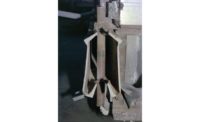
Structural engineers are harnessing technology's power to learn from failures and ultimately improve the built environment. New interactive digital databases—similar to YouTube, SharePoint and Wikipedia—offer the potential to improve codes and practice, agree engineers. With global engineering research, knowledge and failure data at their fingertips, designers are able to connect the dots as never before.
"We are on the brink of [an information] revolution," said engineer Santiago Pujol at the 2012 Structures Congress, held on March 29-31 in Chicago and organized by the Structural Engineering Institute (SEI) of the American Society of Civil Engineers, Reston, Va. "We now have tools to organize data and offer it to the public so we can write better codes and more," said Pujol, an associate professor in the school of civil engineering at Purdue University, West Lafayette, Ind.
One program, created by Purdue's HUBzero Platform for Scientific Collaboration, is ahead of the pack. The structures component, called NEEShub, within the George E. Brown Jr. Network for Earthquake Engineering Simulation (NEES.org), went live on July 31, 2010.
Users can upload quake data to the hub, as with YouTube, or collaborate, as with SharePoint. And like Wikipedia, the hub lets people create Wiki-like pages on subjects. One interactive part, called inDEED, allows design simulations.
The seven-year-old Confidential Reporting of Structural Safety (CROSS) program of the London-based Institution of Structural Engineers (IStructE) provides a digital way to sound the alarm anonymously about unsafe design and construction practices. After a committee of experts, including lawyers, reviews the reports, they are disseminated in a monthly newsletter to subscribers.
One topic of concern is the issue of forged quality-assurance documentation for structurally critical components. All topics are of "international interest and relevance," said Sarah Fray, IStructE's director of technical and engineering services. The forged documents "may have contributed to at least one major structural failure," she added.
Engineers outside the U.K. are welcome to file reports. However, to make that easier, IStructE launched, in January 2011, CROSS International as part of its revamped Structural-Safety.org website. At Structures Congress, IStructE officials met with their SEI counterparts to explore a collaboration. "With SEI formally engaging as a stakeholder in CROSS and with the formation of a dedicated CROSS USA section, the development of a powerful international safety reporting system would take a leap forward," said Fray.
SEI is considering the idea, said Sam A. Rihani, SEI's 2012 president and a principal of the Reston-based engineer that bears his name.
Permissions Needed to Use Data



Post a comment to this article
Report Abusive Comment